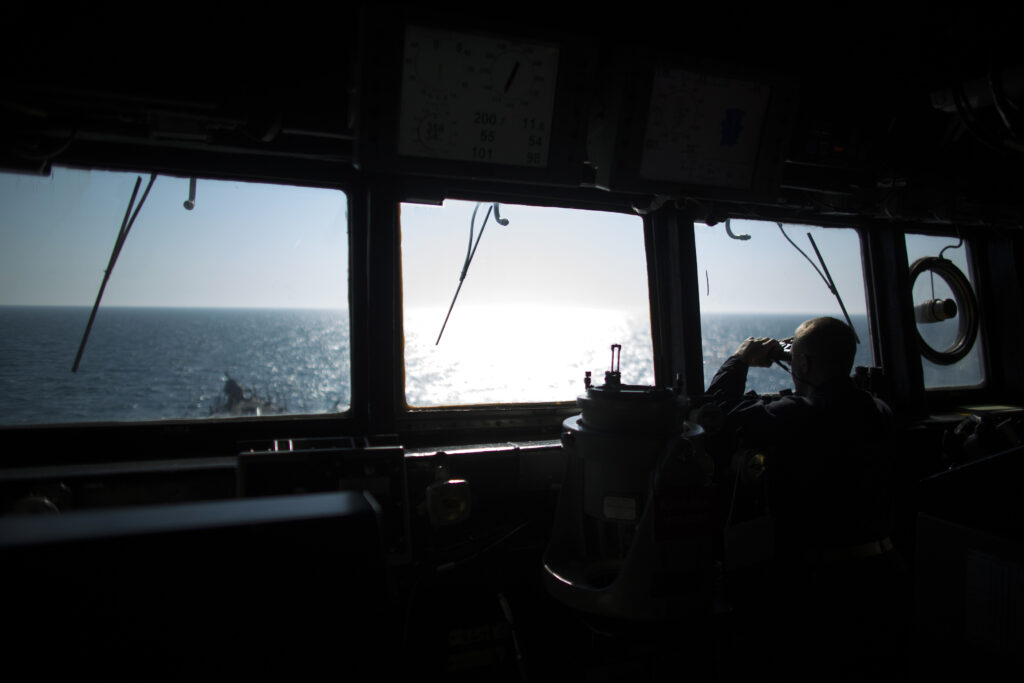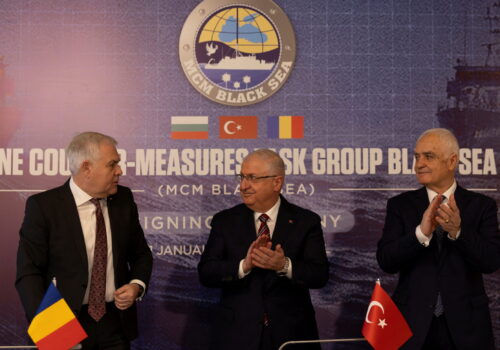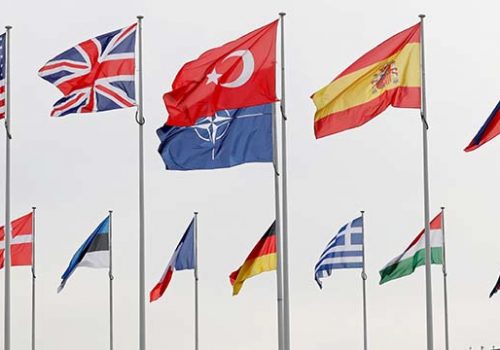Ukrainian President Volodymyr Zelenskyy said that Ukraine would continue to work with the United States on a peace deal following a tense meeting with US President Donald Trump last month. But even if the new US president achieves a deal between Russia and Ukraine, the peace that Trump has committed to achieve isn’t guaranteed. For that, the United States needs a wider Black Sea strategy.
To bring about a cease-fire in the war in Ukraine, the Trump administration has signaled a willingness to normalize relations with Russia via enhanced economic relations with a heavily sanctioned Moscow.
This course of action presents a dramatic turn from the prior US policy of unflinching support to Ukraine and opposition to Russian aggression. The Trump administration’s goals are ambitious and multifaceted: secure a rapid end to the war in Ukraine, coerce Europeans to contribute more to their security, and entice Russia into more deeply embracing the United States (instead of China) using economic incentives. Complementing the tentative rapprochement between Washington and Moscow is a minerals deal between the United States and Ukraine that would see the two countries jointly develop Ukraine’s mineral resources. If it goes through, the deal would provide Kyiv with a coveted link to Washington, though no clearly defined security guaranties have been identified in the draft agreement.
The Trump administration’s pursuit of these goals is not without risk. Russian President Vladimir Putin could view Trump’s overtures as signs of weakness, which might lead him to double down on aggressive actions or drag out negotiations to achieve a better bargaining position. Russia has a less-than-stellar record of honoring its agreements with Ukraine, so there is a bad precedent. Russia’s complex, centuries-long security obsessions vis-à-vis the West will not be assuaged by promises of economic collaboration with the United States. And even with a cessation of hostilities, convincing foreign investors to return to Russia may not be easy. Additionally, it is unclear whether better relations and economic concessions from the United States, in some Nixonian grand-strategy coup, will manage to drive Russia to weaken its links with China.
Even if a peace deal is struck, the wider Black Sea region will remain a militarized, unstable, and contested space. The end of hostilities in Ukraine does not necessarily mean the end of conflict; it is possible that Russia will gladly accept Western attention while using the lull to rest and rebuild its armed forces for a rematch with Ukraine. Russia regularly launches hybrid warfare attacks on its neighbors, and the peace deal will likely not bar the Kremlin from continuing to meddle elsewhere. Vulnerable non-NATO states Moldova and Georgia are already under extreme pressure from Moscow. Longtime regional competitors Russia and Turkey, despite their uneasy rapprochement in recent years, could see renewed friction along one of many traditional fault lines. Finally, more than just traditional littoral states are now deeply involved in the Black Sea region’s security, as shown by the introduction of North Korean forces into the war.
Trump has repeatedly stated his desire to quickly resolve the war in Ukraine. But the United States can’t stop there. Since the region is in proximity to major trade routes—such as the Suez Canal, the Middle Corridor, and routes that transport Middle Eastern energy—the United States may not have the luxury of walking away from the Black Sea without consequences for US trade and commerce that would require Washington’s attention later.
This creates even more reason for the Trump administration to develop a Black Sea security and development strategy, the pillars for which are enshrined in the 2024 National Defense Authorization Act. Those pillars are designed to increase coordination with NATO and the European Union, deepen economic ties (particularly in energy), and bolster democratic principles and good governance. While those pillars lack detail, they provide a solid framework that emphasizes economic development, energy security, and infrastructure support that provides investment opportunities for US firms. That all aligns with the administration’s priorities.
The president’s desire to fashion his own policy initiatives and to distance himself from his predecessor could drive him to revise the existing strategy framework to emphasize economic development or produce clear security guarantees. Such a Black Sea strategy, if fully developed, could act as a hedge should Russia continue its regional adventurism.
Assuming a Trump-negotiated cease-fire takes hold, the United States has allies in the region, notably Turkey and Romania, which are natural staging areas for Ukraine’s reconstruction and other efforts that would be part of a comprehensive Black Sea strategy. Turkey, which is home to the Incirlik Air Base and provides access to the Black Sea via the straits, is positioning itself as a regional military, economic, and political power. Romania has a growing strategic footprint, centered on the Mihail Kogălniceanu Air Base and the Port of Constanța on the Black Sea. Furthermore, Romania is rapidly improving its defense capabilities, particularly through the acquisition of US weapons systems. Bucharest has consistently met the requirement to spend 2 percent of its GDP on defense and could reach 3 percent by 2027.
The wider Black Sea region will continue to be a fragile geopolitical environment and the threats to US interests there will not subside with the cessation of hostilities in Ukraine. Trump understands the region’s importance and its value for US commercial and strategic interests. In July 2017, early in his first administration, Trump expressed support for the Three Seas Initiative (a forum of countries located along the Baltic, Adriatic, and Black Seas), noting that it “will not only empower your people to prosper, but it will ensure that your nations remain sovereign, secure, and free from foreign coercion.” That vision for peace and prosperity in the region will require more than a cease-fire in Ukraine; it will require a new Black Sea security and development strategy that unleashes economic development and greater private-sector activity under US leadership.
Arnold C. Dupuy is a nonresident senior fellow at the Atlantic Council IN TURKEY and chair of the NATO Science and Technology Organization’s SAS-183, “Energy Security Capabilities, Resilience and Interoperability.” Follow him on LinkedIn.
The views expressed in TURKEYSource are solely those of the authors and do not necessarily reflect the views of the Atlantic Council, its staff, or its supporters.
Further reading
Fri, Feb 21, 2025
In strengthening its security architecture, Europe shouldn’t discount Türkiye’s role
TURKEYSource By
Europe needs to look outside of its current framework for security solutions. Türkiye can play a role.
Wed, Nov 13, 2024
Quiet before the storm: Is a new maritime security order taking shape in the Black Sea region?
TURKEYSource By
While Turkey and Europe have their own maritime strategies for the Black Sea, finding ways of cooperation is critical to counter Russia's maritime power.
Wed, Oct 16, 2024
Turkey and the West’s Black Sea interests converge more often than is acknowledged—opening up opportunities for cooperation
TURKEYSource By
Turkey and the West have clear opportunities for more effective cooperation in the Black Sea, but both sides need to show will.
Image: A U.S. sailor uses binoculars during a joint military drill at the U.S. Navy guided-missile destroyer USS Truxtun in the Black Sea, near Bulgaria and Romania, March 19, 2014. The U.S. guided-missile destroyer carried out another round of navy drills in the Black Sea on Wednesday, the latest display of American military power just a few hundred miles away from Russian-annexed Crimea. The USS Truxtun, a warship capable of carrying 96 missiles and torpedoes and equipped with a special radar system, performed exercises in calm waters with fellow NATO members Romania and Bulgaria, following a similar round last week. REUTERS/Stoyan Nenov (BULGARIA - Tags: POLITICS MILITARY)



